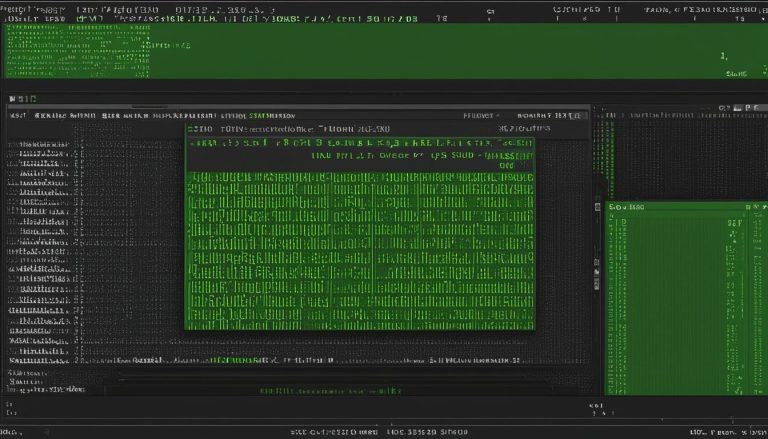Today, I will be taking you on a deep dive into the world of APT (Advanced Package Tool). APT is a powerful Linux package manager that enables efficient management of software packages, updates, and dependencies.
As a widely used tool in the Linux community, APT provides a command-line interface for managing software installations, upgrades, and removals. It simplifies package management by automatically resolving dependencies and retrieving packages from designated repositories.
With APT, system administrators and users can easily install new software, update existing packages, and troubleshoot any issues that may arise. Its user-friendly interface and extensive documentation make it a popular choice for both novice and experienced Linux users.
Key Takeaways:
- APT (Advanced Package Tool) is a Linux package manager that provides efficient management of software packages, updates, and dependencies.
- APT simplifies package management by automatically resolving dependencies and retrieving packages from repositories.
- It offers a command-line interface for installing, updating, and removing software packages.
- APT is widely used in the Linux community due to its user-friendly interface and extensive documentation.
- System administrators and users can rely on APT for reliable package management and troubleshooting.
The Characteristics and Trends of APT Attacks
Advanced persistent threat (APT) attacks exhibit distinct characteristics and follow specific trends in the ever-evolving landscape of cybersecurity. APT attacks are not limited to high-value entities but also pose a threat to smaller organizations and unconventional targets. These attacks have witnessed several trends, including the utilization of supply chain attacks and the adoption of APT-style tactics by non-state-sponsored threat actors, particularly in ransomware attacks.
APT attacks typically involve multiple stages, each requiring specific techniques and tools to achieve the attacker’s objectives. The stages include target selection, external reconnaissance, initial access, malware execution, privilege escalation, lateral movement, data exfiltration, and damage infliction. Throughout these stages, attackers employ sophisticated methods to evade detection and gain unauthorized access to valuable assets within a compromised network.
In recent years, supply chain attacks have gained prominence as a strategy employed by APT threat actors. By compromising smaller enterprises, attackers can gain access to larger targets that may have robust security measures in place. Additionally, non-state-sponsored threat actors have adopted APT-style tactics, especially in ransomware attacks, which have witnessed a surge in frequency and sophistication.
To gain a deeper understanding of APT attacks and their evolving nature, it is essential to explore the trends and characteristics that define them. By recognizing these traits, organizations can enhance their cybersecurity measures to mitigate the risks posed by APT attacks.
Table: APT Attack Stages
| Stage | Description |
|---|---|
| Target Selection | Identifying potential targets based on strategic objectives. |
| External Reconnaissance | Gathering information about the target through public sources and open-source intelligence. |
| Initial Access | Gaining unauthorized access to the target’s network or system. |
| Malware Execution | Deploying malicious software to establish persistence and control within the network. |
| Privilege Escalation | Elevating access privileges to gain further control over the target’s resources. |
| Lateral Movement | Expanding the attack’s reach within the network by moving laterally to other systems and devices. |
| Data Exfiltration | Stealing sensitive data or information from the target’s network. |
| Damage Infliction | Causing harm, disruption, or financial loss to the target’s network or systems. |
SolarWinds Supply Chain Attack, Marriot Hotels Data Breach, and Ireland Health Service Executive Ransomware Attack
The world of cybersecurity has been rocked by several high-profile APT attacks in recent years. These attacks have not only exposed vulnerabilities in software and systems but have also highlighted the evolving tactics and motivations of threat actors. Let’s take a closer look at three prominent APT attacks and their far-reaching impacts.
SolarWinds Supply Chain Attack
The SolarWinds supply chain attack, discovered in late 2020, sent shockwaves through the cybersecurity community. This highly sophisticated attack involved compromising the update mechanism of SolarWinds’ Orion software, which is used by numerous organizations around the world. With the tainted update, the attackers gained unauthorized access to thousands of organizations, including government agencies and major enterprises.
The impact of the SolarWinds attack was extensive, exposing significant weaknesses in software supply chain security. It showcased the potential for attackers to target trusted software vendors and use their updates as a vehicle for spreading malware. This attack highlighted the need for increased vigilance and scrutiny when it comes to supply chain security.
Marriot Hotels Data Breach
In 2018, the Marriot Hotels data breach made headlines for its massive scale and impact. The breach involved unauthorized access to the guest reservation database, resulting in the theft of personal data from approximately 500 million guests. The stolen information included names, addresses, phone numbers, passport numbers, and even credit card details.
The Marriot Hotels data breach highlighted the risks of inadequate cybersecurity measures and the potential consequences for individuals and organizations alike. It served as a wake-up call for the hospitality industry and emphasized the need for robust data protection strategies to safeguard customer information.
Ireland Health Service Executive Ransomware Attack
The Ireland Health Service Executive (HSE) ransomware attack, which occurred in May 2021, demonstrated the evolving tactics of ransomware threat actors. The attack utilized APT-style techniques to gain unauthorized access to the HSE’s systems and encrypt its data, demanding a ransom for its release. This attack caused widespread disruption to Ireland’s healthcare system, impacting patient care and highlighting the potentially devastating consequences of ransomware attacks.
The Ireland HSE ransomware attack showcased how threat actors are incorporating APT tactics to maximize their impact and increase their chances of financial gain. It also underscored the importance of robust cybersecurity measures, proactive threat detection, and incident response strategies to mitigate the risks posed by ransomware attacks.
| APT Group | Motivations | Targeted Sectors |
|---|---|---|
| APT28 (Fancy Bear) | Cyber Espionage | Government, Defense, Energy |
| APT29 (Cozy Bear) | Cyber Espionage | Government, Defense, Technology |
| APT38 (Lazarus) | Financial Gain | Financial Institutions |
| APT41 (Wicked Panda) | Financial Gain, Hacktivism | Technology, Gaming, Telecommunications |
| APT34 (Helix Kitten) | Cyber Espionage | Government, Energy, Technology |
As the threat landscape continues to evolve, organizations and individuals must remain vigilant and proactive in their cybersecurity efforts. Learning from the lessons of these prominent APT attacks, implementing robust security measures, and staying informed about emerging threats are crucial steps in safeguarding against future cyber-attacks.
State-sponsored APT Groups and Their Objectives
State-sponsored APT groups are highly sophisticated cyber attackers who receive support or funding from national governments. These groups engage in targeted cyber espionage campaigns, aiming to infiltrate foreign governments, multinational corporations, critical infrastructure, or influential individuals. With significant resources at their disposal, state-sponsored APT groups carry out operations aligned with their sponsoring state’s strategic interests.
One example of a state-sponsored APT group is Charming Kitten APT. This Iranian-based group has been active since at least 2014 and is known for its cyber espionage activities. Charming Kitten APT targets individuals and organizations primarily in the Middle East, particularly those involved in politics, diplomacy, and human rights activism.
Another prominent state-sponsored APT group is APT41. Based in China, APT41 is unique in that it conducts both state-sponsored and financially motivated cyber attacks. APT41’s objectives range from gathering intelligence and engaging in cyber espionage to conducting financially motivated attacks for personal gain. This group has targeted various sectors, including telecommunications, healthcare, and the gaming industry.
APT38, also known as Lazarus, is a North Korean state-sponsored APT group primarily focused on financial gain. This group has been involved in numerous high-profile cyber attacks targeting banks and financial institutions worldwide. APT38’s operations often include hacking into financial networks, stealing funds, and conducting ATM cash-outs.
State-sponsored APT groups are driven by different objectives, including cyber espionage, financial gain, hacktivism, and destruction. Their advanced techniques and resources pose significant challenges for cybersecurity professionals and require constant vigilance to defend against their attacks.
Table: State-sponsored APT Groups and Their Objectives
| Group | Country | Objectives |
|---|---|---|
| Charming Kitten APT | Iran | Cyber espionage, targeting individuals and organizations involved in politics, diplomacy, and human rights activism. |
| APT41 | China | Cyber espionage, financial gain, targeting various sectors including telecommunications, healthcare, and gaming. |
| APT38 (Lazarus) | North Korea | Financial gain, targeting banks and financial institutions through hacking, fund theft, and ATM cash-outs. |
Conclusion
After delving into the world of Advanced Persistent Threats (APTs), it is clear that these cyber-attack campaigns pose a significant threat to organizations and individuals alike. APTs are not limited to government entities and critical infrastructure; smaller organizations and unconventional targets are also at risk.
The SolarWinds supply chain attack, the Marriot Hotels data breach, and the Ireland Health Service Executive ransomware attack are prominent examples of APT attacks that have exposed vulnerabilities in cybersecurity measures. These incidents serve as a reminder of the importance of robust security practices and constant vigilance in the face of evolving cyber threats.
State-sponsored APT groups, such as Charming Kitten APT, APT41, and APT38, play a significant role in cyber espionage, financial gain, hacktivism, and destruction. These groups utilize advanced techniques and resources to achieve their objectives, which align with the strategic interests of their sponsoring states.
As APT attacks continue to evolve and grow in sophistication, it is crucial for organizations and individuals to stay informed about APT trends and the strategies employed by these state-sponsored groups. By understanding the nature of APTs and implementing robust cybersecurity measures, we can better protect ourselves against these relentless threats.
FAQ
What is an APT (Advanced Persistent Threat)?
An APT is a cyber-attack in which the adversary operates undetected inside a compromised network for an extended period of time after gaining unauthorized access.
What distinguishes APT attacks from other cyber-attacks?
APT attacks are distinguished by their use of highly sophisticated tools and techniques to evade detection, steal credentials, and move through the network to reach high-value assets.
Who are the typical targets of APT attacks?
APT attacks are often carried out by nation-states or state-sponsored organizations, targeting government entities, critical infrastructure, and major enterprises.
What are the stages involved in an APT attack?
APT attacks involve multiple stages, including target selection, external reconnaissance, initial access, malware execution, privilege escalation, lateral movement, data exfiltration, and damage infliction.
Can smaller organizations or non-conventional targets be at risk of APT attacks?
Yes, several trends indicate that smaller organizations or non-conventional targets are also at risk, including the use of supply chain attacks and the adoption of APT-style tactics by non-state-sponsored threat actors.
What are some notable APT attacks in recent history?
Some notable APT attacks include the SolarWinds supply chain attack, the Marriot Hotels data breach, and the Ireland Health Service Executive ransomware attack.
What are state-sponsored APT groups?
State-sponsored APT groups are cyber attackers who receive support or funding from national governments. They engage in sophisticated cyber espionage campaigns targeted at foreign governments, multinational corporations, critical infrastructure, or influential individuals.
What are the objectives of state-sponsored APT groups?
The objectives of state-sponsored APT groups can include cyber espionage, financial gain, hacktivism, or destruction, depending on the strategic interests of their sponsoring state.
Hi, I’m Mark, the author of Clever IT Solutions: Mastering Technology for Success. I am passionate about empowering individuals to navigate the ever-changing world of information technology. With years of experience in the industry, I have honed my skills and knowledge to share with you. At Clever IT Solutions, we are dedicated to teaching you how to tackle any IT challenge, helping you stay ahead in today’s digital world. From troubleshooting common issues to mastering complex technologies, I am here to guide you every step of the way. Join me on this journey as we unlock the secrets to IT success.


